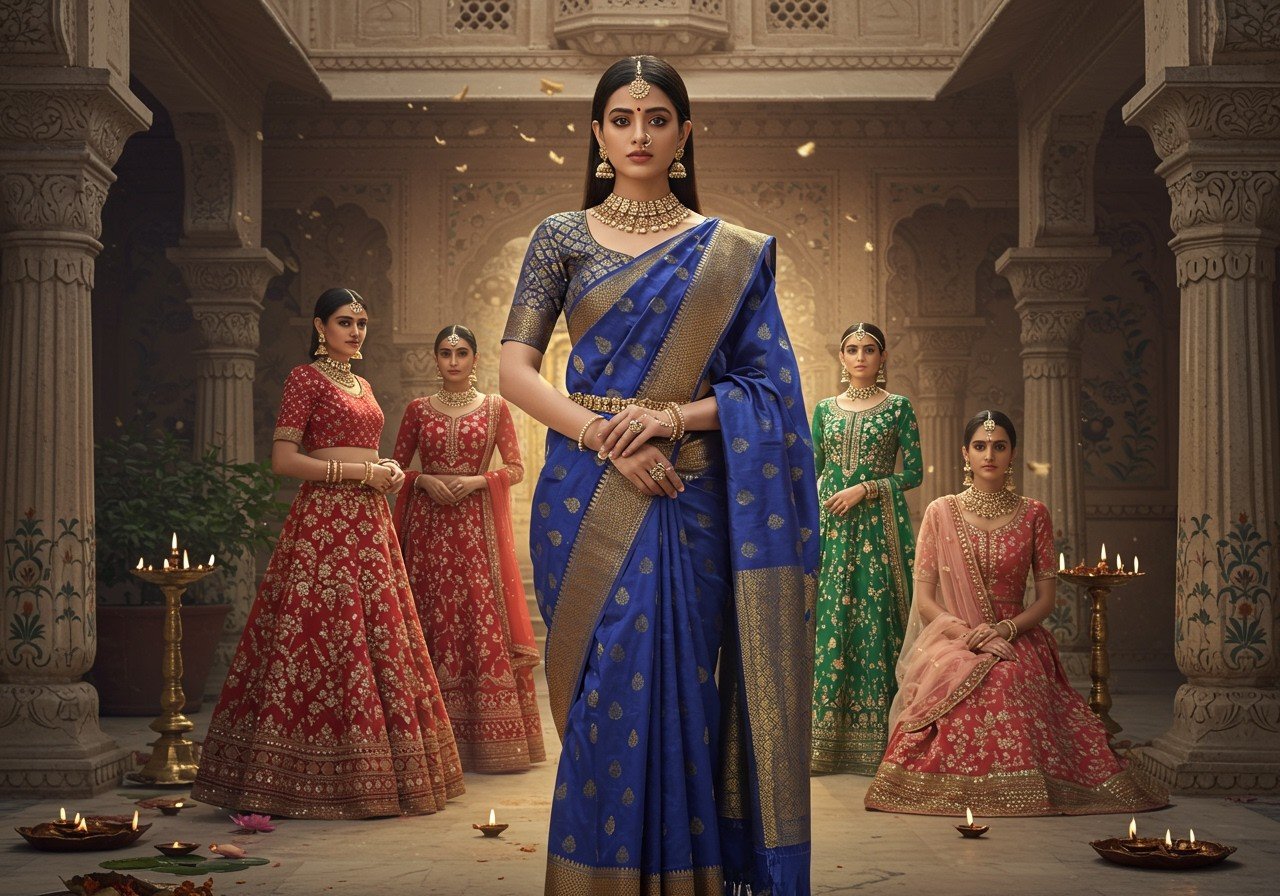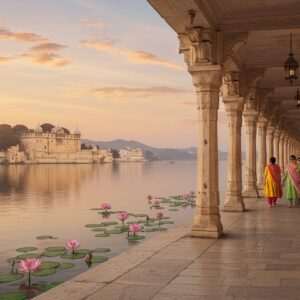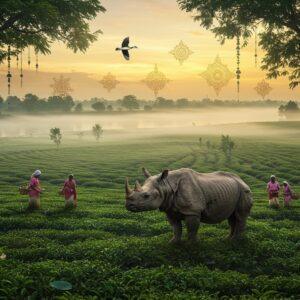
Embark on a captivating exploration of traditional Indian clothing, a vibrant tapestry woven with threads of history, spirituality, and regional diversity. More than mere garments, these attire represent India’s rich cultural heritage, embodying centuries of tradition and artistry. Clothing and cultural identity are deeply intertwined for Indians, with traditional attire significantly influencing modern fashion trends. This exploration holds immense value for culturally rooted individuals who cherish tradition and seek authentic cultural expression. At poojn.in, we understand and celebrate this rich heritage.
The Symbolism and Significance of Traditional Garments
Traditional Indian clothing carries profound symbolic meaning. Sarees, with their intricate designs and vibrant colors, represent femininity, social status, and regional identity. The way a saree is draped varies across India, each style telling a unique cultural story. You can find a wide variety of sarees at poojn.in. For men, the dhoti and kurta embody simplicity and cultural pride. Turbans, particularly significant in Sikh culture, signify honor, respect, and regional affiliations. Garments like the angavastram hold deep spiritual and ritualistic meaning in religious practices. Furthermore, specific colors and patterns woven into the fabric convey messages of prosperity, purity, and spirituality, adding layers of meaning to each garment.
Regional Variations in Attire: A Celebration of Diversity
India’s diverse regions are reflected in the vast array of traditional clothing styles. North Indian attire, such as the comfortable salwar kameez and elegant sherwani, mirrors the climatic and cultural nuances of the region. The vibrant chaniya cholis of Gujarat hold particular cultural importance during festivals like Navratri. In South India, silk sarees, especially the exquisite Kanjeevaram, symbolize wealth and tradition, often adorning brides at weddings. Eastern India boasts unique styles like the graceful Assamese mekhela chador, representing simplicity and elegance. Furthermore, the colorful attire of Northeastern India, such as the intricate Naga shawls, draws inspiration from the rich tapestry of tribal culture. These regional variations not only showcase India’s incredible diversity but also play a crucial role in preserving its vibrant cultural heritage. For those seeking traditional attire, poojn.in offers an array of options.
The Sacred Role of Clothing in Religious Ceremonies
Traditional clothing holds a place of reverence in Indian religious ceremonies. The pristine white garments worn during Hindu rituals symbolize purity and peace, creating an atmosphere of serenity and devotion. In Sikh ceremonies, specific attire, known as the five Ks, is integral to the faith, representing core principles and values. Traditional Muslim clothing, such as the hijab and burqa, maintains modesty and signifies religious identity. The vibrant colors of garments worn in Jain and Buddhist rituals express joy and devotion, enhancing the celebratory atmosphere. In essence, traditional clothing fosters a sense of community and belonging among participants in religious events, seamlessly bridging the spiritual and material worlds. poojn.in provides a curated selection of items for various religious needs.
The Evolution and Modernization of Traditional Attire
Traditional Indian clothing has gracefully evolved through the ages, adapting to changing times while preserving its core essence. Colonial influences have undoubtedly shaped contemporary fashion, yet traditional elements remain deeply ingrained. Fusion wear, a popular trend, seamlessly blends Western styles with Indian designs, creating innovative and fashionable garments like Indo-Western dresses. Moreover, there’s a growing resurgence of interest in handloom fabrics and artisanal craftsmanship, highlighting the value of traditional techniques and supporting local artisans. Technology and the rise of e-commerce have made traditional clothing more accessible than ever before, allowing Indians worldwide to reconnect with their cultural roots. Platforms like poojn.in cater to this global demand, making it easier for individuals to embrace and celebrate their heritage. Bollywood, India’s vibrant film industry, also plays a significant role in popularizing traditional attire on a global scale, showcasing its beauty and versatility to a wider audience.
Traditional Indian Clothing: A Timeless Expression of Identity
Traditional Indian clothing represents more than just fabric and fashion; it embodies a vibrant tapestry of history, culture, and identity. Wearing these garments connects individuals to a rich legacy of grace, pride, and spirituality. Each piece, from the flowing saree to the simple kurta, tells a story of heritage and belonging, preserving cultural traditions for generations to come. Today, with the convenience of online platforms like poojn.in, embracing and celebrating one’s cultural identity through traditional attire is easier than ever before. This harmonious blend of tradition and modern convenience empowers individuals to honor their past while stepping confidently into the future, draped in the rich legacy of their ancestors.
Frequently Asked Questions about Traditional Indian Clothing
What is the symbolism of the saree? The saree is more than just a garment; it’s a symbol of femininity, grace, and tradition. Worn during festivals and ceremonies, it embodies cultural heritage and regional identity, with each draping style telling a unique story.
Why are turbans worn in different regions of India? Turbans hold deep cultural and religious significance, representing honor, respect, and sometimes even community or social standing. Their styles vary regionally, adding to India’s rich tapestry of traditions.
How does traditional clothing vary across India’s regions? India’s regional diversity is reflected in its clothing. From the ghagra choli of Rajasthan to the mundu of Kerala, each region has unique garments shaped by culture, climate, and local traditions.
What role does clothing play in Indian religious ceremonies? Clothing plays a significant role in religious ceremonies, symbolizing purity, devotion, and respect. Specific garments like dhotis and sarees are chosen for their spiritual significance and add to the sanctity of rituals. poojn.in offers incense sticks and other items to enhance your spiritual practices.
What is the significance of colors in traditional Indian clothing? Colors in Indian attire hold deep symbolic meanings. Red represents prosperity and is often worn by brides, while white symbolizes purity and is associated with mourning or spiritual practices. Each color adds a layer of meaning to the garment.
What is the significance of embroidery in Indian garments? Embroidery adds an element of artistry and meaning to clothing. Techniques like zari and zardozi embellish garments, often depicting stories, spiritual symbols, or cultural motifs, enhancing their beauty and significance.
How are traditional Indian clothes adapted for modern use? Designers now offer pre-stitched sarees, lighter fabrics, and contemporary cuts, blending tradition with convenience for everyday wear without sacrificing cultural essence. You can find modern adaptations of traditional clothing at poojn.in.
Why do Indian brides wear lehengas or sarees for weddings? Lehengas and sarees are considered auspicious for weddings, symbolizing new beginnings, prosperity, and the bride’s cultural heritage. Their elegance and intricate designs add to the grandeur of the occasion.


